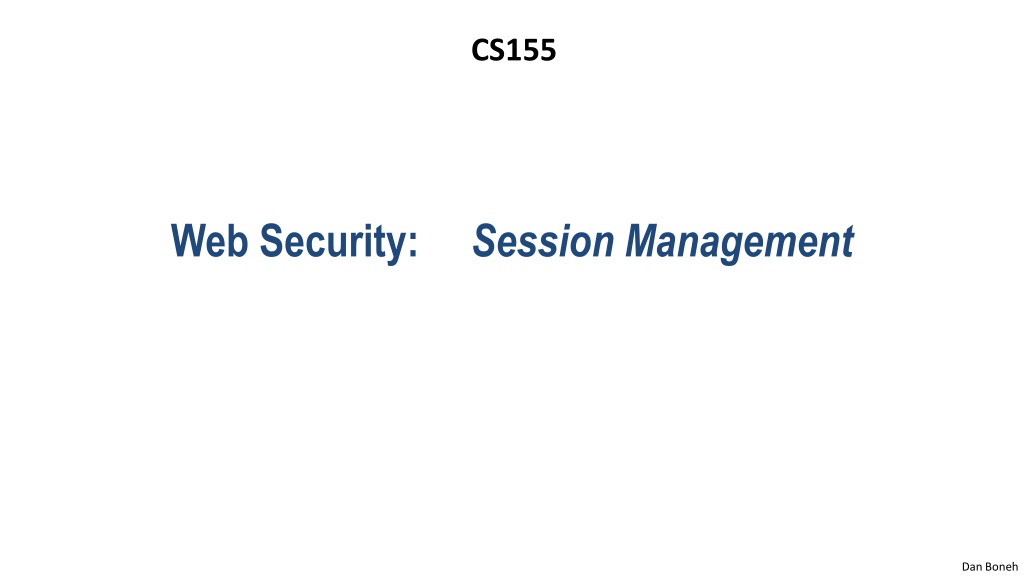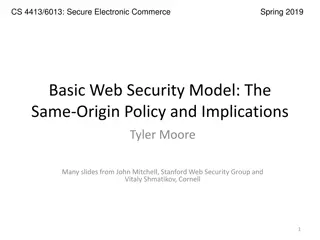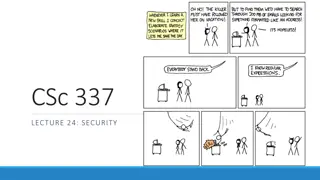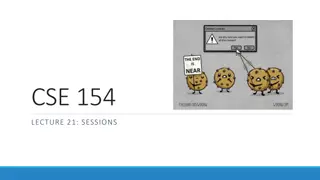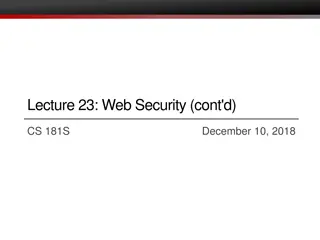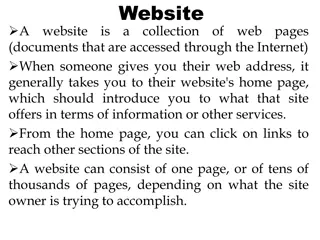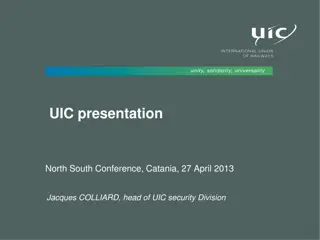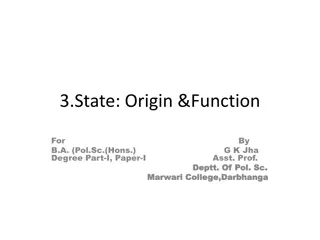Understanding Session Management and Same-Origin Policy in Web Security
Explore the concepts of session management, same-origin policy, and cookie handling for web security, as explained by Dan Boneh. Learn about setting and deleting cookies, scope setting rules, cookie identification, and reading cookies on the server. Understand the implications of these practices for maintaining secure web environments.
Download Presentation

Please find below an Image/Link to download the presentation.
The content on the website is provided AS IS for your information and personal use only. It may not be sold, licensed, or shared on other websites without obtaining consent from the author. Download presentation by click this link. If you encounter any issues during the download, it is possible that the publisher has removed the file from their server.
E N D
Presentation Transcript
CS155 Web Security: Session Management Dan Boneh
Same origin policy: review Review: Same Origin Policy (SOP) for DOM: Origin A can access origin B s DOM if match on (scheme, domain, port) This lecture: Same Original Policy (SOP) for cookies: Based on: ([scheme], domain, path) optional scheme://domain:port/path?params Dan Boneh
Setting/deleting cookies by server GET Browser Server HTTP Header: Set-cookie: NAME=VALUE ; domain = (when to send) ; path = (when to send) secure = (only send over SSL); expires = (when expires) ; HttpOnly SameSite = [lax | strict] scope if expires=NULL: this session only if expires=past date: browser deletes cookie weak XSS defense weak CSRF defense Default scope is domain and path of setting URL Dan Boneh
Scope setting rules (write SOP) domain: any domain-suffix of URL-hostname, except TLD example: host = login.site.com allowed domains login.site.com .site.com disallowed domains other.site.com othersite.com .com login.site.com can set cookies for all of .site.com but not for another site or TLD Problematic for sites like .stanford.edu (and some hosting centers) path: can be set to anything Dan Boneh
Cookies are identified by (name,domain,path) cookie 1 name = userid value = test domain = login.site.com path = / secure cookie 2 name = userid value = test123 domain = .site.com path = / secure distinct cookies Both cookies stored in browser s cookie jar both are in scope of login.site.com Dan Boneh
Reading cookies on server (read SOP) Browser GET //URL-domain/URL-path Cookie: NAME = VALUE Server Browser sends all cookies in URL scope: cookie-domain is domain-suffix of URL-domain, and cookie-path is prefix of URL-path, and [protocol=HTTPS if cookie is secure ] Goal: server only sees cookies in its scope Dan Boneh
Examples both set by login.site.com cookie 1 name = userid value = u1 domain = login.site.com path = / secure cookie 2 name = userid value = u2 domain = .site.com path = / non-secure cookie: userid=u2 cookie: userid=u2 cookie: userid=u1; userid=u2 http://checkout.site.com/ http://login.site.com/ https://login.site.com/ Dan Boneh
Client side read/write: document.cookie Setting a cookie in Javascript: document.cookie = name=value; expires= ; Reading a cookie: prints string containing all cookies available for document (based on [protocol], domain, path) alert(document.cookie) Deleting a cookie: document.cookie = name=; expires= Thu, 01-Jan-70 HttpOnly cookies: not included in document.cookie Dan Boneh
Javascript URL javascript: alert(document.cookie) Displays all cookies for current document Dan Boneh
Cookie protocol problems Dan Boneh
Cookie protocol problems Server is blind: Does not see cookie attributes (e.g. secure, HttpOnly) Does not see which domain set the cookie Server only sees: Cookie: NAME=VALUE Dan Boneh
Example 1: login server problems 1. Alice logs in at login.site.com login.site.com sets session-id cookie for .site.com 2. Alice visits evil.site.com overwrites .site.com session-id cookie with session-id of user badguy 3. Alice visits course.site.com to submit homework course.site.com thinks it is talking to badguy Problem: course.site.com expects session-id from login.site.com; cannot tell that session-id cookie was overwritten Dan Boneh
Example 2: secure cookies are not secure Alice logs in at https://accounts.google.com set-cookie: SSID=A7_ESAgDpKYk5TGnf; Domain=.google.com; Path=/ ; Expires=Wed, 09-Mar-2026 18:35:11 GMT; Secure; HttpOnly set-cookie: SAPISID=wj1gYKLFy-RmWybP/ANtKMtPIHNambvdI4; Domain=.google.com;Path=/ ; Expires=Wed, 09-Mar-2026 18:35:11 GMT; Secure Alice visits http://www.google.com (cleartext) Network attacker can inject into response Set-Cookie: SSID=badguy; secure and overwrite secure cookie Problem: network attacker can re-write HTTPS cookies ! HTTPS cookie value cannot be trusted Dan Boneh
Interaction with the DOM SOP Cookie SOP path separation: x.com/A does not see cookies of x.com/B Not a security measure: x.com/A has access to DOM of x.com/B <iframe src= x.com/B"></iframe> alert(frames[0].document.cookie); Path separation is done for efficiency not security: x.com/A is only sent the cookies it needs Dan Boneh
Cookies have no integrity User can change and delete cookie values Edit cookie database (FF: cookies.sqlite) Modify Cookie header (FF: TamperData extension) Silly example: shopping cart software Set-cookie: shopping-cart-total = 150 ($) User edits cookie file (cookie poisoning): Cookie: shopping-cart-total = 15 ($) Similar problem with hidden fields <INPUT TYPE= hidden NAME=price VALUE= 150 > Dan Boneh 16
Not so silly (old) D3.COM Pty Ltd: ShopFactory 5.8 @Retail Corporation: @Retail Adgrafix: Check It Out Baron Consulting Group: WebSite Tool ComCity Corporation: SalesCart Crested Butte Software: EasyCart Dansie.net: Dansie Shopping Cart Intelligent Vending Systems: Intellivend Make-a-Store: Make-a-Store OrderPage McMurtrey/Whitaker & Associates: Cart32 3.0 pknutsen@nethut.no: CartMan 1.04 Rich Media Technologies: JustAddCommerce 5.0 SmartCart: SmartCart Web Express: Shoptron 1.2 Source: http://xforce.iss.net/xforce/xfdb/4621 Dan Boneh 17
Solution: cryptographic checksums Goal: data integrity Requires server-side secret key k unknown to browser Generate tag: T MACsign(k, SID ll name ll value ) k Set-Cookie: NAME = Browser T value Server Cookie: NAME = T value Verify tag: MACverify(k, SID ll name ll value, T) Binding to session-id (SID) makes it harder to replay old cookies Dan Boneh
Example: ASP.NET System.Web.Configuration.MachineKey Secret web server key intended for cookie protection Creating an encrypted cookie with integrity: HttpCookie cookie = new HttpCookie(name, val); HttpCookie encodedCookie = HttpSecureCookie.Encode (cookie); Decrypting and validating an encrypted cookie: HttpSecureCookie.Decode (cookie); Dan Boneh 19
Session Management Dan Boneh
Sessions A sequence of requests and responses from one browser to one (or more) sites Session can be long (e.g. Gmail) or short without session mgmt: users would have to constantly re-authenticate Session mgmt: authorize user once; All subsequent requests are tied to user Dan Boneh
Pre-history: HTTP auth HTTP request: GET /index.html HTTP response contains: WWW-Authenticate: Basic realm="Password Required Browsers sends hashed password on all subsequent HTTP requests: Authorization: Basic ZGFddfibzsdfgkjheczI1NXRleHQ= Dan Boneh
HTTP auth problems Hardly used in commercial sites: User cannot log out other than by closing browser What if user has multiple accounts? multiple users on same machine? Site cannot customize password dialog Confusing dialog to users Easily spoofed Dan Boneh
Session tokens web site Browser GET /index.html set anonymous session token GET /books.html anonymous session token check credentials (crypto) POST /do-login Username & password elevate to a logged-in session token POST /checkout logged-in session token Validate token Dan Boneh
Storing session tokens: Lots of options (but none are perfect) Browser cookie: Set-Cookie: SessionToken=fduhye63sfdb Embed in all URL links: https://site.com/checkout ? SessionToken=kh7y3b In a hidden form field: <input type= hidden name= sessionid value= kh7y3b > Dan Boneh
Storing session tokens: problems Browser cookie: browser sends cookie with every request, even when it should not (CSRF) Embed in all URL links: token leaks via HTTP Referer header (or if user posts URL in a public blog) In a hidden form field: does not work for long-lived sessions Best answer: a combination of all of the above. Dan Boneh
The HTTP referer header Referer leaks URL session token to 3rd parties Referer supression: not sent when HTTPS site refers to an HTTP site in HTML5: <a rel= noreferrer href=www.example.com> Dan Boneh
The Logout Process Web sites must provide a logout function: Functionality: let user to login as different user Security: prevent others from abusing account What happens during logout: 1. Delete SessionToken from client 2. Mark session token as expired on server Problem: many web sites do (1) but not (2) !! Especially risky for sites who fall back to HTTP after login Dan Boneh
Session hijacking Dan Boneh
Session hijacking Attacker waits for user to login then attacker steals user s Session Token and hijacks session attacker can issue arbitrary requests on behalf of user Example: FireSheep [2010] Firefox extension that hijacks Facebook session tokens over WiFi. Solution: HTTPS after login Dan Boneh
Beware: Predictable tokens Example 1: counter user logs in, gets counter value, can view sessions of other users Example 2: weak MAC. token = { userid, MACk(userid) } Weak MAC exposes k from few cookies. Apache Tomcat: generateSessionId() Returns random session ID [server retrieves client state based on sess-id] Dan Boneh
Session tokens must be unpredictable to attacker To generate: use underlying framework (e.g. ASP, Tomcat, Rails) Rails: token = MD5( current time, random nonce ) Dan Boneh
Beware: Session token theft Example 1: login over HTTPS, but subsequent HTTP Enables cookie theft at wireless Caf (e.g. Firesheep) Other ways network attacker can steal token: Site has mixed HTTPS/HTTP pages token sent over HTTP Man-in-the-middle attacks on SSL Example 2: Cross Site Scripting (XSS) exploits Amplified by poor logout procedures: Logout must invalidate token on server Dan Boneh
Mitigating SessionToken theft by binding SessionToken to client s computer A common idea: embed machine specific data in SID Client IP addr: makes it harder to use token at another machine But honest client may change IP addr during session client will be logged out for no reason. Client user agent: weak defense against theft, but doesn t hurt. SSL session id: same problem as IP address (and even worse) Dan Boneh
Session fixation attacks Suppose attacker can set the user s session token: For URL tokens, trick user into clicking on URL For cookie tokens, set using XSS exploits Attack: (say, using URL tokens) 1. Attacker gets anonymous session token for site.com 2. Sends URL to user with attacker s session token 3. User clicks on URL and logs into site.com this elevates attacker s token to logged-in token 4. Attacker uses elevated token to hijack user s session. Dan Boneh
Session fixation: lesson When elevating user from anonymous to logged-in: always issue a new session token After login, token changes to value unknown to attacker Attacker s token is not elevated. Dan Boneh
Summary Always assume cookie data retrieved from client is adversarial Session tokens are split across multiple client state mechanisms: Cookies, hidden form fields, URL parameters Cookies by themselves are insecure (CSRF, cookie overwrite) Session tokens must be unpredictable and resist theft by network attacker Ensure logout invalidates session on server Dan Boneh
THE END Dan Boneh
